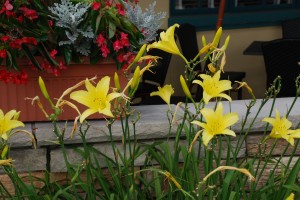‘Hyperion’, a mid-season June-July bloomer, was designated the 2011 Award of Merit winner by the British Horticultural Society. That’s not bad for a daylily (Hemerocallus spp.) variety that was introduced in 1924. It’s still very popular among gardeners and garden designers. You see it everywhere, planted in shopping mall parking lots or along NC highways.
‘Hyperion’ is a deciduous diploid cultivar (USDA hardiness zones 3-8). It adds an old-fashioned elegance to any sunny garden spot as well a sweet lemony fragrance. For almost a month long, its striking 5-inch clear yellow blooms stand 30-36 inches tall. The 24-inch mounds of medium green, strap-like foliage stay mostly blemish-free throughout the summer.
Daylilies thrive in full sunlight (6-hours minimum) and in average moist well-drained soils. They do prefer a deep, fertile loam. Established plants are drought tolerant, but do need minimal watering their first summer during dry spells. It is not unusual, particularly during a wet summer, to develop a brief second cycle of flowering. You may want to deadhead spent floral scapes for neatness.
Hyperion is excellent for naturalizing and a good choice for erosion control on steep embankments. Clumps grow rapidly should be divided every 5 years to maintain vigor and prevent overcrowding. Late summer or late winter (before the spring growth surge) is a good time to divide daylilies. Feed plants in early spring with a slow release fertilizer such as Nutricote™ or Osmocote™. Spring mulching aids in weed suppression and less watering.
Daylilies attract numerous butterflies, and rabbits don’t appear to favor them. Deer, however, are a different creature!


 Posted in
Posted in 
